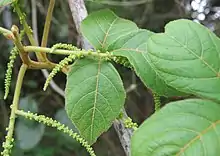Allophylus cobbe
Allophylus cobbe, or titberry, is a plant bearing alternately and spirally arranged ternate leaves belonging to the family Sapindaceae. The edible fruit is three chambered like Sapindus trifoliatus.
| Allophylus cobbe | |
|---|---|
 | |
| Scientific classification | |
| Kingdom: | Plantae |
| Clade: | Tracheophytes |
| Clade: | Angiosperms |
| Clade: | Eudicots |
| Clade: | Rosids |
| Order: | Sapindales |
| Family: | Sapindaceae |
| Genus: | Allophylus |
| Species: | A. cobbe |
| Binomial name | |
| Allophylus cobbe | |
| Synonyms | |
| |
Distribution
Allophyllus cobbe is a variable plant with a broad distribution in India, Sri Lanka, South Africa, South America, Southeast Asia, and Papua New Guinea.[2]
Description
The plants size is 10 metres (33 ft) high and 13 m (43 ft) in width. It has no stipules. The leaves of a plant are trifoliolate, while the leaflets are penni-veined, and could be from densely to glabrous hairy. The flower size is approximately 3 millimetres (0.12 in) in diameter, and are yellow-whitish coloured. The fruits are red in colour and are 8 mm (0.31 in) in diameter.[3]
Ecology
The plant grows in mixed dipterocarp ecosystems. It can also be found in coastal and sub-montane forests at an altitude of 1,700 m (5,600 ft). It grow commonly along rivers and streams (tidal included), on hillsides, and forest edges. It grows on sandy or clay soils, and can also be found on limestone and ultrabasic environments. It can exist as a pre-disturbance remnant in secondary forests.[3]
Uses
The plant can be used for roofing, firewood and bows.[2] It can also be used for making rafts and fish traps. The bark, roots and leaves of the tree could be used to treat fever and stomach ache. The fruits, although edible, could be used as fish poison.[3]
References
- "Allophylus cobbe". Germplasm Resources Information Network (GRIN). Agricultural Research Service (ARS), United States Department of Agriculture (USDA). Retrieved 2010-12-26.
- Distribution and uses
- Description, ecology, and use of a plant